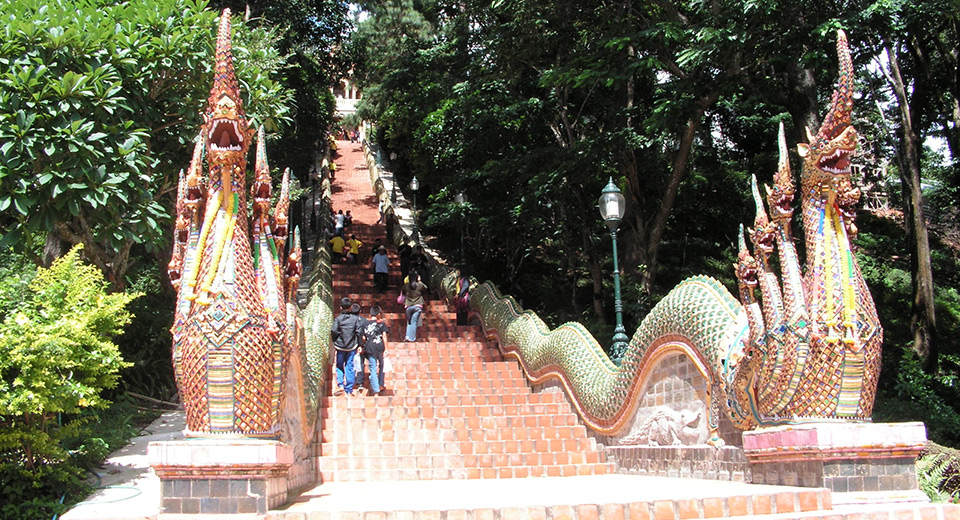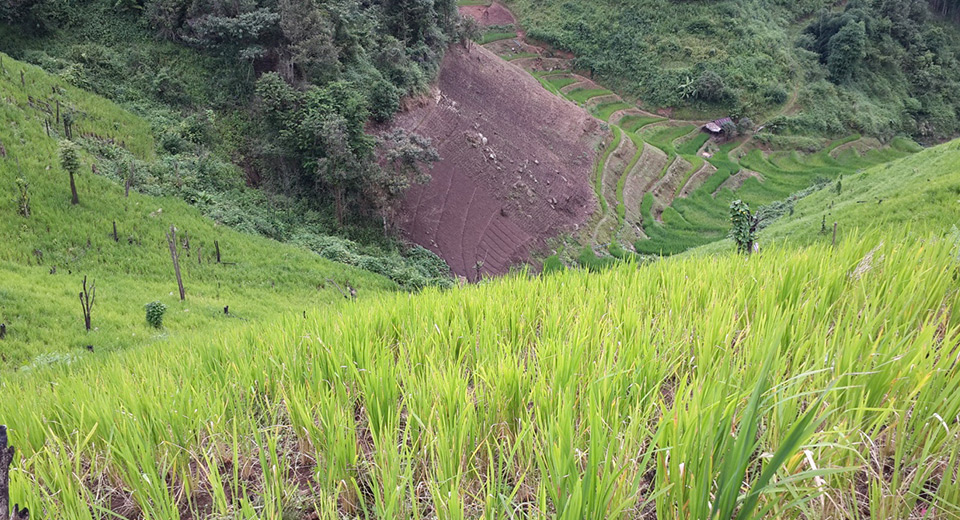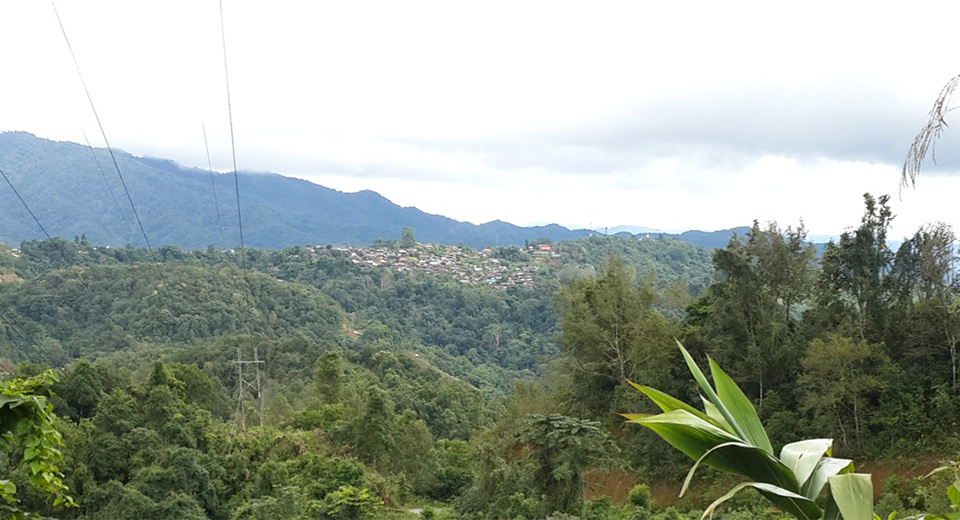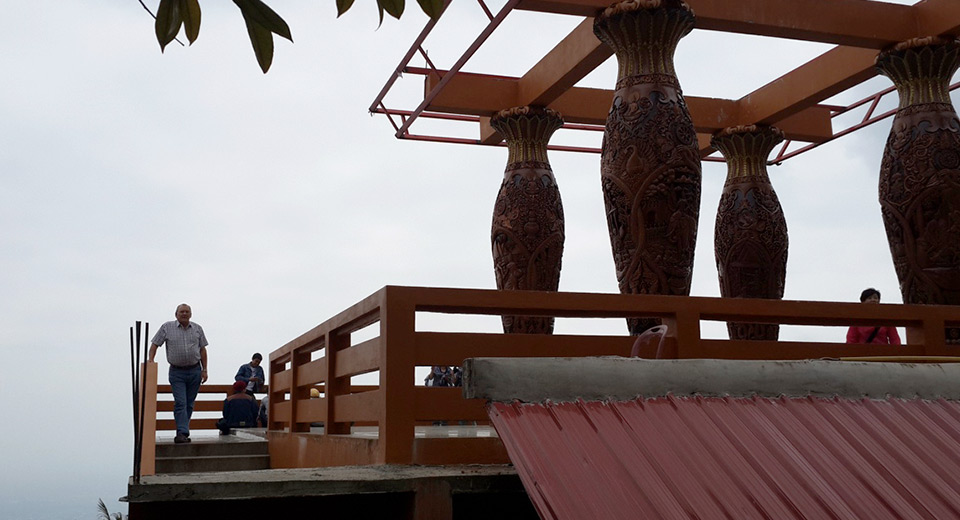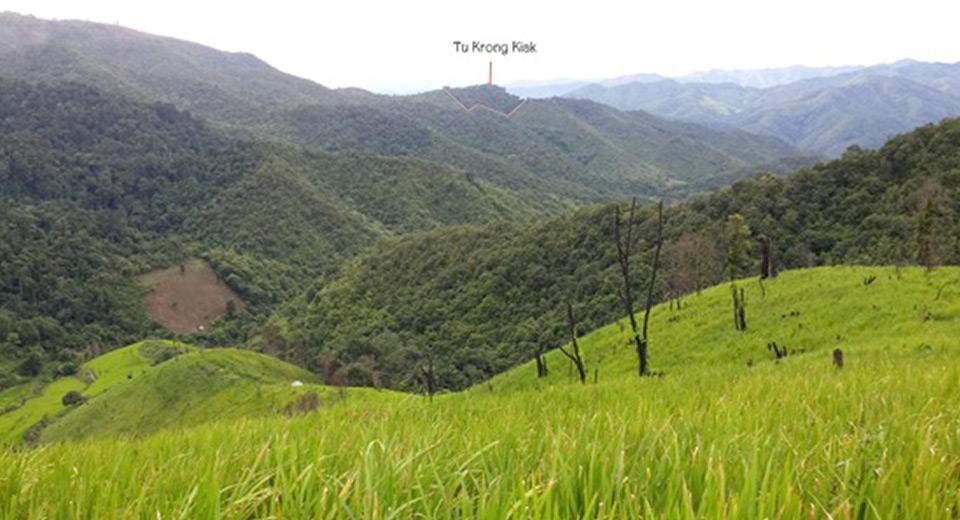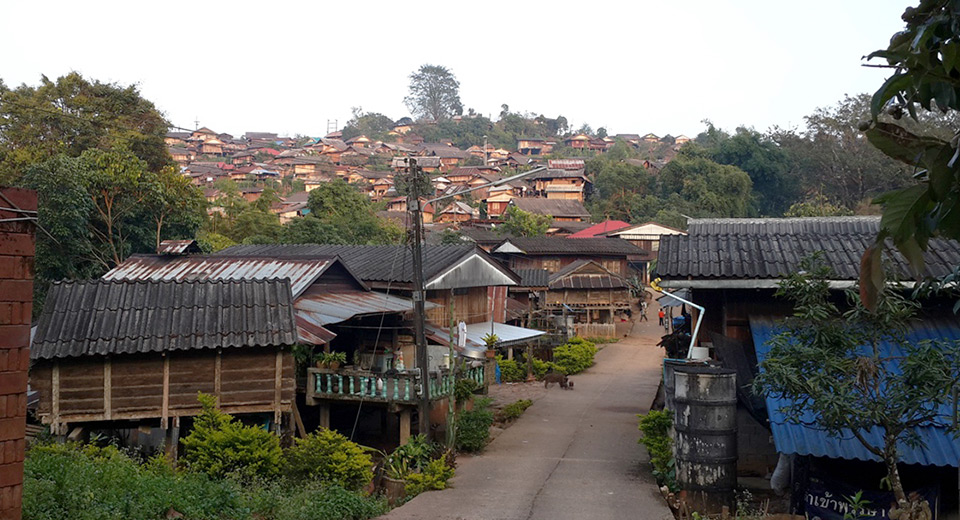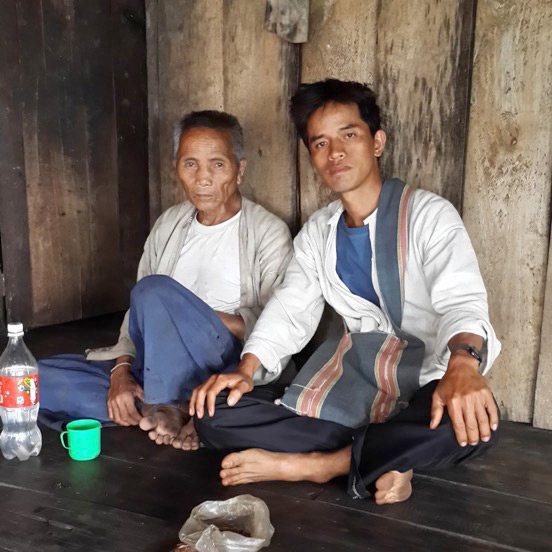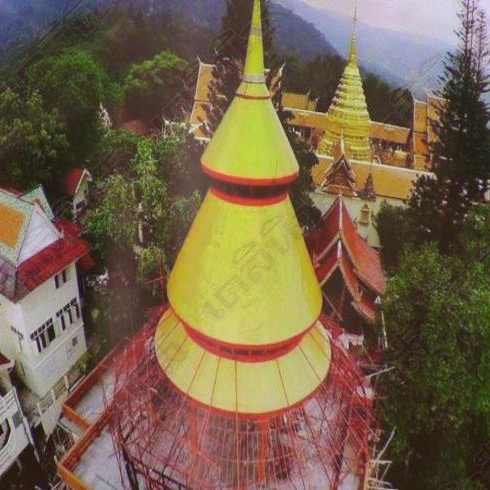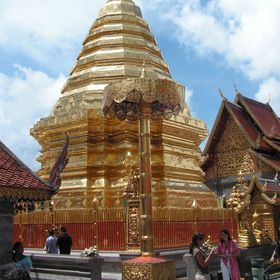"... Is iad sléibhte an t-ionad cumarsáide a nascann an dá ríocht talamh agus neamh le chéile. Sléibhte, mar sin féin, nach ionann iad agus stádas geografach amháin, ach tá bríonna naofa ann freisin a bhaineann le bunús na treibheanna eitneacha Tai…" - Hongsuwan
suíomh Cur síos
I sléibhte Chiang Mai cónaí ar na daoine Lua, a bhfuil ceangal láidir spioradálta acu le roinnt de na suíomhanna áitiúla arda. Tá a sinsir ina gcónaí sa réigiún le breis 1300 bliana. Tugann siad ómós do na dea- agus do na droch-spiorad le deasghnátha leis an teaghlach. Tá an ceantar chomh maith le teach saibhir, foraoise dea-chaomhnaithe. Le teacht na turasóireachta sa réigiún, athraíonn údaráis áitiúla an tírdhreach ar bhealaí nach mbíonn comhaontú na ndaoine áitiúla i gcónaí leo. Is é bunú túr radhairc ar shuíomh teampall naofa an sampla is suntasaí.
Bagairtí
Toisc gur ar ghnéithe cultúrtha agus amhairc na talún ba mhó a dhírigh an staidéar seo, is é an phríomhbhagairt anseo ná coinbhleacht folaithe idir stíleanna maireachtála a bhaineann le sruthanna reiligiúnacha nó cultúrtha éagsúla. Is cosúil gur bagairt leanúnach é gan aon tionchar tobann ar na luachanna bithchultúrtha áitiúla sa ghearrthéarma., ach láithreacht fhadtéarmach leanúnach. Tháinig an cath chun tosaigh go hachomair timpeall ar bhunú túr breathnadóireachta turasóireachta in aice leis an teampall suaitheanta ar Shliabh Doi Suthep, rud a fheiceann roinnt daoine dúchasacha mar smál ar fhéiniúlacht chultúrtha naofa an tsuímh. Léiriú eile ar an gcoimhlint seo is ea an cheist cé chomh mór is atá stíleanna feirmeoireachta traidisiúnta mhuintir Lua ag déanamh dochair nó ag tacú leis an éiceachóras..
Fís
Go dtí seo, tá roinnt fís éagsúil ann don réimse seo, ag brath ar an eagraíocht nó na daoine a iarrtar. Cé go mbaineann roinnt grúpaí go príomha le luachanna nádúrtha an éiceachórais a chosaint, tá sé mar aidhm ag cinn eile turasóirí reiligiúnacha agus neamhreiligiúnacha a mhealladh agus roinnt ioncaim a ghiniúint don cheantar. Cé go bhfuil an dá cheann seo comhoiriúnach go ginearálta trí éiceathurasóireacht, is cosúil gur fearr le muintir Lua féin an chuid is mó dá scrínte agus cleachtais chultúrtha a choinneáil mar atá siad, Ós rud é go bhfuil a stíleanna maireachtála ag freastal go maith orthu le breis agus mílaoise. Tá roinnt acadóirí den tuairim gur cheart do bhainisteoirí páirceanna a gcuid eolais éiceolaíochta traidisiúnta a ghlacadh níos dáiríre.
Ag obair le chéile
Go dtí seo, níl naisc an-láidir ag líonra pobail Lua leis na heagraíochtaí atá i bhfeighil na páirce náisiúnta. Tá gníomhartha na ndaoine i gcoinne an túr, áfach, mar thoradh ar chaibidlíocht agus ar chomhaontú an spuaic a bhaint as a bharr agus airde an túir a laghdú faoi urlár amháin. D’fhéadfadh sé seo a bheith dearfach do cheisteanna amach anseo, mar a léirigh sé do mhuintir Lua go bhfuil coiste an teampaill sásta éisteacht le cuid dá n-éilimh ar a laghad. B'fhéidir go dtiocfadh caidreamh muiníne níos dlúithe as seo amach anseo.
Polasaí agus Dlí
Maíonn údaráis an Teampaill go bhfuil na cearta dlíthiúla acu agus go bhfuil úinéireacht acu ar an suíomh, a d'fhéadfadh siad a úsáid chun é a athchruthú de réir toil. Tá an suíomh suite taobh amuigh d'údarás cosanta ranna eile de chuid na Mínealaíne, Foraoiseacht agus Páirceanna Náisiúnta.
Is é príomhchuspóir Pháirc Náisiúnta Doi Suthep-Pui ná próisis chomhshaoil a chosaint agus a chur chun cinn, agus oideachas comhshaoil agus caitheamh aimsire á spreagadh.
Éiceolaíocht & Bithéagsúlacht
Tá éiceachóras sléibhtiúil Pháirc Náisiúnta Doi Suthep-Pui mar chuid de shléibhte Thanon Thong Chai. Tá a aeráid fionnuar, le meán séasúrach idir 6 agus 23°C. Tá uisce flúirseach sna easanna áitiúla iomadúla a thacaíonn le fás na bhforaoisí duillsilteacha agus síorghlasa le Oaks agus Magnolias.. Tithe an pháirc os a chionn 300 speicis éan neadaithe, amfaibiaigh annamh, an Muntjac coitianta (Muntiacus muntjak) agus an torc fiáin (Síol muc). Maíonn roinnt daoine gur bhreathnaigh siad ar phóir annamha fianna bána ag tafann agus préacháin bhána, ach níl láithreacht na n-ainmhithe seo fíoraithe.
Choimeádaithe
Is iad na Lua na háitritheoirí is ársa i bpáirc náisiúnta Doi Suthep-Pui, caidreamh domhain spioradálta a bheith aige leis an sliabh. Is beochainteoirí iad go traidisiúnta, ach tá siad faoi thionchar láidir Búdachais anois. Feictear dóibh an tírdhreach mar rud spreagtha agus domhain, uaireanta meas eaglach ar a gcuid tailte. Creidtear go bhfuil déithe a bhfuil cumhachtaí draíochta sonracha acu ina gcónaí i limistéir an-naofa mar bharr sléibhe. Déanann daoine Lua íobairtí madraí agus sicíní chun a meas ar dhéithe áitiúla i suíomhanna teaghlaigh a chur in iúl. Níl cead acu cuairt a thabhairt ar beanna. Le haghaidh feirmeoireachta, úsáideann siad córas rothlaithe barr le timthriallta de thart ar tríocha bliain, áit a n-úsáidtear paiste amháin ar feadh naoi mbliana as a chéile, ansin ar chlé a chur ar ais ar feadh fiche. Tá cosc ar sheilg i suíomhanna naofa áirithe, agus creidtear go mbuailfidh siad siúd a bhriseann an riail naofa seo bás mistéireach. Cé go bhfuil cónaí ar na daoine Lua a saol spioradálta den chuid is mó ar bhonn aonair agus eolach, shamans sráidbhaile, tá ról tábhachtach ag sliocht ó cheannairí ársa i deasghnátha móra ag cur oideachas ar mhuintir an bhaile ar sheanchas a dtailte.
Gníomh
Tá agóidí ar bun ag muintir Chiang Mai i gcoinne tógáil túr faire Doi Suthep, mar gheall ar an laghdú atá tagtha ar an bhuntuiscint chultúrtha ar áit. Ar feadh roinnt míonna, rinne siad ionadaíocht ar a gcearta trí mháirseáil ar shráideanna chathair Chang Mai.
Caomhnú uirlisí
Úsáideann córas feirmeoireachta mhuintir Lua timthriallta fada buan chun barr a tháirgeadh, athfhás foraoise a chur san áireamh agus díghrádú ithreach a sheachaint. Déantar plandáil roinnt speiceas ríse a thráth de réir shéasúr na báistí. Barra inite eile, cosúil le glasraí, cuirtear luibheanna agus torthaí ar láithreacha randamacha sna réimsí ríse. Cuirtear pónairí soighe chun an ithir a thorthú trí fosúchán nítrigine. Sa tslí, cruthaíonn muintir Lua tailte feirme éagsúla ina seachnaítear luibhicídí go héifeachtach. Tar éis an chéad phlota feirmeoireachta eile a shuiteáil, a 6-8 m stripe na gcrann a laghdú go dtí stumpaí, ina dhiaidh sin dóitear an paiste foraoise istigh. De réir a chéile, fásann na stumpaí ar ais go foraoisí toirseacha san am a úsáidtear an paiste foraoise le haghaidh feirmeoireachta.
Torthaí
Cé go bhfuil oidhreacht nádúrtha an tsuímh caomhnaithe agus aitheanta go maith ag muintir na háite chomh maith le húdaráis pháirceanna, tá obair fós le déanamh chun oidhreacht chultúrtha mhuintir Lua a chosaint. Is í an chaibidlíocht ar an túr sárscéimhe an toradh is geallta ar an ábhar sin. Ina theannta sin cuireann staidéir a rinne an Ollscoil náisiúnta le déanaí le feasacht idirnáisiúnta nua, agus b'fhéidir tacú le cumhachtaí margála mhuintir Lua i gcoimhlintí amach anseo.
"Iarracht mhíthreorach atá ann an túr a chur isteach sa tírdhreach a raibh an teampall amháin go traidisiúnta i gceannas air. Is é an toradh atá air ná íomhá spéirlíne de dhá thúr ar bharr Shliabh Doi Suthep, rud a laghdaíonn an ceannas cultúrtha agus amhairc bunaidh., braistint áite agus oidhreacht chultúrtha doláimhsithe an teampaill." - Ponpandecha & Taylor 2016.
- Pongpandecha & Taylor 2016 I: Verschuuren & Furuta (eds) Daoine Lua: traidisiúin, Creidimh agus Láithreáin Naofa Nádúrtha i? Tuaisceart na Téalainne. I: Láithreáin Nádúrtha na hÁise Naofa: Fealsúnacht agus Cleachtas i gCeantair faoi Chosaint agus a Chaomhnú. Routledge, Londain. pp. 247-259.

